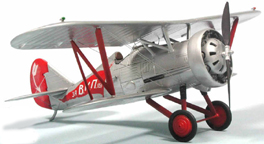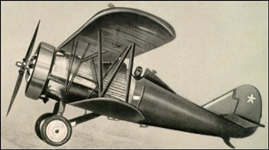July, 1937

Polikarpov I-5
Model Airplane News Cover Art for July, 1937
by Jo Kotula
Click to Enlarge
The Polikarpov I-5 was a single-seat biplane which became the primary Soviet fighter between its introduction in 1931 through 1936, after which it became the standard advanced trainer.


Polikarpov I-5

Polikarpov I-5 As A Parasite Fighter
attached to the Tupolev TB-3 heavy bomber
Click to Enlarge
A look at the I-5 provides some insight into the hazards of being a brilliant aeronautical engineer in 1920s Russia. The 1928 Five-Year Plan ordered the Tupolev design bureau to develop a mixed-construction (metal and wood/fabric) biplane fighter powered by an imported Bristol Jupiter VII engine with the first prototype to be completed by 1 September 1929. The new fighter was designated I-5 (Istrebitel = "Fighter"), but had the internal Tupolev designation of ANT-12. Concurrently, Nikolai Nikolaevich Polikarpov's group was tasked with creating a wood-construction aircraft designated as the Polikarpov I-6 to the same specification. The I-5 design lagged because the Tupolev bureau was preoccupied with large bombers. As the result the I-5 and I-6 projects were unified in 1929 under Polikarpov's leadership. Neither project met its specified completion date and Polikarpov was arrested by the OGPU [State Secret Police] for "industrial sabotage" He was quickly sentenced to death, although this was commuted to ten years imprisonment in a labor camp. In December 1929 the OGPU gathered a number of aircraft engineers together at Butyrka prison and formed the Internal Prison Design Bureau. Shortly afterwards Polkarpov became the head designer when his concept for the I-5 was approved by the OGPU.
It made its first flight in April of 1930 One problem noted during the trials was a tendency to make an uncontrolled 180° turn when landing in light winds. Shortening the landing gear cured the problem. The engineer who suggest the change was awarded the Order of the Red Star for his ingenuity. The first IL-5 was named for the State Commissar of Industrial Production and glowingly dedicated to the Soviet People. 54 I-5s were delivered by October 1931, and 66 by the end of the year. The I-5 began to be replaced by the Polikarpov I-15 in 1936, and was completely phased out from front-line use by the end of 1937, but continued to be employed as an advanced trainer.
The I-5 was involved in tests of the Zveno project where a Tupolev TB-3 heavy bomber carried three I-5s as parasite fighters. One I-5 was carried was on each wing and a third over the fuselage. This was so cumbersome that they were generally used solely as an extra powerplant for the TB-3.
The surprise German invasion of Russia destroyed most of the Soviet Air Forces and illustrated the dangerous obsolescence of cloth and wood biplanes. As far as can be determined, neither the OGPU nor any State Commisars were held accountable for this debacle. However, surviving I-5s were equipped with four machine guns and bomb racks and pressed into service as light ground-attack aircraft and night bombers in 1941. They were retired in early 1942 as Soviet aircraft production began to recover and modern ground-attack aircraft like the Ilyushin Il-2 "Sturmovik" became available.
So much for designing aircraft by decree.
Click Here for more information about the Polikarpov I-5.

Click to go back and select another cover.
Counter for the Entire Site (not just this page..)
Home | About Lindy | Last Week's Reviews | Upcoming Events | 1940s Collecibles
The Guide - Establishments - Travel - Accessories
Music | Links | Photo Gallery | Extras | Contact